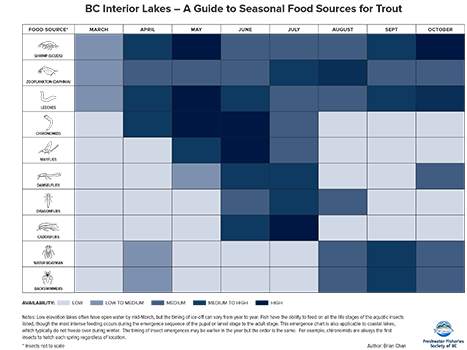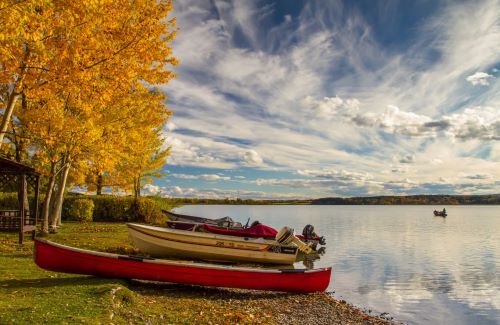I often get asked when is the best time of year to fish for trout in lakes. Unfortunately, it is not a simple answer, since there can be good fishing at all times of year – including ice-fishing in winter. However, there is a lot to be said about the spring and fall seasons.
Spring has good fishing because water temperatures are warming, and that stimulates fishes’ feeding activity. Also, the majority of aquatic insect emergences occur during the spring and early-summer months, and trout and char feed heavily on these prolific hatches.
In autumn, trout again feed aggressively, not necessarily on insect hatches, but rather on the same insects’ immature nymphal or larval stages, along with other invertebrates (like leeches, freshwater shrimp, water boatman, and backswimmers). Since there are many reasons why fall fishing can be outstanding, let’s take a closer look at why we should be out on the water over the next couple of months.
Based on dropping water temperatures during autumn, fishing can be broken down into early-, mid-, and late-season. Since all fish are cold-blooded, each species has temperature ranges in which they are the most active. When water temperatures go above that range in the summer, or below that during winter, the metabolisms and feeding levels of trout and char slow – often reflected in their unwillingness to bite! Dropping autumn air temperatures allow the lake water to also cool down, which brings fish back into a feeding state.
Trout and char living in the thousands of small lakes of the province’s Interior will endure several months of ice cover. During fall, fish need to put on as much body fat as possible to get them through the long winter. When the shallow or shoal areas of a lake cool down enough, it is more comfortable for fish to forage for longer periods of time and, in preparation for winter, feed even more aggressively as the temperatures continue to drop.

Early-fall season
This usually coincides with the month of September as air temperatures are slowly dropping, and water temperatures get down to the 15° to 16°C (60° to 62°F) range. Calm, sunny days will see water boatman and backswimmer flights. Trout will aggressively feed on both species as these bugs hit the surface of the water, and as they swim down and back up from the bottom after depositing their eggs. Watch for what appears as raindrops hitting the water, and swirling riseforms of trout taking these bugs. Having eaten so many chironomids during the spring and early summer, there may also be some early-fall hatches which the trout will focus on.
As water temperatures continue to drop the trout will begin to move into shallower water to feed on leeches, juvenile damselfly, dragonfly nymphs, and shrimp or scuds. Look for fish in prime depths of five to six metres (15 to 18 feet).
Mid-fall season
Typically by late September, surface temperatures are now into the 10° to 13°C (50° to 55°F) range. Trout will start feeding more heavily, and continue to push into shallower water. The cooler water and higher oxygen levels will increase the general activity levels, including the feeding intensity of fish. Trout are becoming more focussed on bread-and-butter food sources like leeches and shrimp. When not feeding in the shallows, the fish will be targeting zooplankton found in dense concentrations out in deeper water.

Late-fall season
The best fishing starts once surface temperatures drop below 10°C (50°F). Trout become much more aggressive in their feeding patterns, and it often occurs in water anywhere from a mere metre (about three feet) to three metres (10 feet) in depth. Again, fish are seeking leeches and shrimp, their main food sources, but immature damselfly nymphs are also important diet items.
Once water temperatures drop below 4°C (39°F), trout feeding levels often slow down. Fish will move out into slightly deeper water, which will be a bit warmer than that of the really shallow areas of the lake.
The duration of the good fall fishing is totally dependant on how slowly or quickly the water temperatures cool. Of course, really cold air temperatures will make it challenging to fish, and by then, the open-water fishing season is soon coming to a close.
General fall fishing tips
Always be on the lookout for active fish: ones that are showing themselves on the surface of the lake. Fish that are rising, jumping, or rolling not only indicate their presence, but potentially, fish that are actively feeding. The key is to fish the areas of the lake where fish are concentrated; move to where the fish are most active. During a day of fall fishing, it is typical to see several short feeding periods. So as not to miss the best feeding frenzies, most successful anglers are prepared to spend the entire day on the water. And as further incentive, the fall fishing season often offers an angler the best chance at catching the biggest fish of the year.
Remember in the fall to fish a lake’s shallower areas – from one to six metres (three to 18 feet) in depth – where the natural food sources of trout and char are found. Try fly-fishing with leech, water boatman, shrimp, and damselfly nymph patterns; trolling Worden’s Triple Teazer or Panther Martin lures; or float-fishing with worms or Berkley PowerBait, just off the lake bottom.
September, October, and November are prime months for fishing lakes throughout the province. However, some of the best Interior lakes to fish include Whiteswan and Whitetail near Kimberley; Tunkwa and Leighton near the town of Logan Lake; Campbell east of Kamloops; and Dragon, just south of Quesnel.
Each fall, the Freshwater Fisheries Society of B.C. also stocks catchable-sized trout in urban lakes situated on southern Vancouver Island, and around the greater Vancouver area. On Vancouver Island, you’ll find some great fishing at Elk/Beaver, Langford, and Thetis lakes. Try Rice, Green Timbers, LaFarge, and Mill lakes in the Lower Mainland. Check the stocking reports for the latest information on which lakes are being stocked.
Originally published September 21, 2016. Updated autumn 2022.
Author: Brian Chan, Fishing Advisor, Freshwater Fisheries Society of BC
Photo Credits: Brian Chan, Craig Adamson and Tim Yesaki, Freshwater Fisheries Society of BC.
